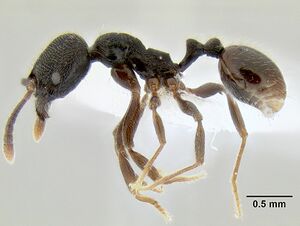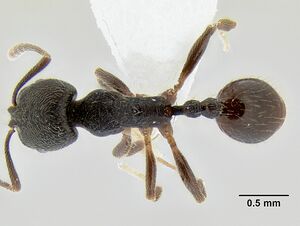Stenamma stictosomum
| Stenamma stictosomum | |
|---|---|

| |
| Scientific classification | |
| Kingdom: | Animalia |
| Phylum: | Arthropoda |
| Class: | Insecta |
| Order: | Hymenoptera |
| Family: | Formicidae |
| Subfamily: | Myrmicinae |
| Tribe: | Stenammini |
| Genus: | Stenamma |
| Species: | S. stictosomum |
| Binomial name | |
| Stenamma stictosomum Branstetter, 2013 | |
A rare species, S. stictosomum is a cloud forest specialist known from a few samples of sifted leaf litter, a beating sample, and from quarantine in Brownsville, TX. The latter specimen was found on orchids being shipped to the United States from either Oaxaca or San Luis Potosí, México. Collections range from 1450–1750 m elevation. The presence of S. stictosomum on orchids and on vegetation (beating sample) suggests that it may nest or at least forage arboreally. This would help explain why the species appears to be so rare, despite being rather widespread.
Identification
Branstetter (2013) - Body color mostly black to dark brown, sometimes with a bluish glare in specimens with coarsely punctate sculpture; small- to medium-sized species (see HL, ML, PrW below); anterior clypeal margin broadly emarginate, with two blunt inner teeth (best viewed with mandibles open); basal margin of mandible sinuous, but without a basal notch or deep depression; setae on gastral tergites sparse, stout, and suberect, only sometimes with a few underlying short decumbent setae; eye relatively large (EL 0.15–0.18, REL 20–25), oval-shaped, with 8–9 ommatidia at greatest diameter; head and mesosomal sculpture densely punctate, densely carinulate, or carinulate-punctate, with carinulae merging into punctae; propodeal spines reduced to sharp angles or tubercles (PSL 0.09–0.11, PSI 0.9–1.2); frontal lobes well-developed, but not completely obscuring torular lobes in full-face view (FLD 0.15–0.22, FLI 23–28). Similar species: Stenamma vexator.
Stenamma stictosomum may form a complex of species, as evidenced by the significant amount of morphological variation among populations. However, an adequate assessment of species boundaries is impossible because so little material has been collected of the species (10 specimens from 7 localities).
Keys including this Species
Distribution
Mexico (Atlantic slope) to Honduras.
Latitudinal Distribution Pattern
Latitudinal Range: 21.293° to 14.95284°.
| North Temperate |
North Subtropical |
Tropical | South Subtropical |
South Temperate |
- Source: AntMaps
Distribution based on Regional Taxon Lists
Neotropical Region: Guatemala, Mexico (type locality).
Distribution based on AntMaps
Distribution based on AntWeb specimens
Check data from AntWeb
Countries Occupied
| Number of countries occupied by this species based on AntWiki Regional Taxon Lists. In general, fewer countries occupied indicates a narrower range, while more countries indicates a more widespread species. |

|
Estimated Abundance
| Relative abundance based on number of AntMaps records per species (this species within the purple bar). Fewer records (to the left) indicates a less abundant/encountered species while more records (to the right) indicates more abundant/encountered species. |

|
Biology
Castes
Known only from the worker caste.
Worker
Images from AntWeb
    
| |
| Worker. Specimen code casent0604636. Photographer Michael Branstetter, uploaded by Default Group. | Owned by FMNH. |
      
| |
| Holotype Stenamma stictosomum. Worker. Specimen code casent0605499. Photographer Michael Branstetter, uploaded by Default Group. | Owned by USNM. |
     
| |
| Worker. Specimen code casent0606221. Photographer Michael Branstetter, uploaded by Default Group. | Owned by MGBPC. |

| |
| Worker. Specimen code casent0126245. Photographer Michael Branstetter, uploaded by Default Group. | Owned by USNM. |
   
| |
| Worker. Specimen code casent0126246. Photographer Michael Branstetter, uploaded by Default Group. | Owned by LACM. |

| |
| Specimen code casent0604647. . | |
Nomenclature
The following information is derived from Barry Bolton's Online Catalogue of the Ants of the World.
- stictosomum. Stenamma stictosomum Branstetter, 2013: 249, figs. 157, 158 (w.) MEXICO (Oaxaca, Hidalgo, San Luis Potosi, Veracruz), GUATEMALA.
- Type-material: holotype worker, 2 paratype workers.
- Type-locality: holotype Mexico: Oaxaca, 20.6 km. SW Valle Nacional, 17.60404°N, 96.37786°W±60m., 1740 m., 13.viii.2009, MGB1390 (M.G. Branstetter); paratypes with same data.
- Type-depositories: USNM (holotype); UCDC, UNAM (paratypes).
- Distribution: Guatemala, Mexico.
Unless otherwise noted the text for the remainder of this section is reported from the publication that includes the original description.
Worker
(9 measured) HL 0.73–0.88 (0.88), HW 0.65–0.78 (0.78), FLD 0.15–0.22 (0.22), PCW 0.03–0.04 (0.03), SL 0.56–0.68 (0.68), EL 0.15–0.18 (0.18), ACL 0.51–0.61 (0.61), ML 0.93–1.11 (1.11), PrW 0.44–0.53 (0.53), PSL 0.09–0.11 (0.10), SDL 0.09–0.11 (0.11), PL 0.34–0.40 (0.39), PH 0.23–0.25 (0.25), PW 0.17–0.19 (0.19), PPL 0.20–0.24 (0.24), PPH 0.19–0.23 (0.23), PPW 0.20–0.23 (0.23), MFL 0.64–0.80 (0.77), MTL 0.51–0.65 (0.63), CI 86–94 (88), SI 79–92 (88), REL 20–25 (23), FLI 23–28 (28), PSI 0.9–1.2 (0.9), MFI 94–115 (101), ACI1 63–66 (63), ACI2 87–94 (89).
Small- to medium-sized species; general body color mostly black to dark brown, with appendages brown to orange-brown; setae dark golden brown; mandible with 6–7 teeth, consisting of 3 distinct apical teeth, a distinct basal tooth, and 2–3 teeth in between, which are often worn and indistinct; basal margin of mandible sinuous, but without a basal notch or deep depression; mandible mostly smooth and shining, with scattered piligerous punctae and striae; anterior clypeal margin broadly emarginate, with two blunt inner teeth (best viewed with mandibles open); surface of median clypeal lobe somewhat rough (irregular depressions, punctae), with a pair of faint longitudinal carinulae that diverge anteriorly, apex of lobe with a short transverse carinula, remainder of clypeus mostly smooth and shiny; posterior extension of clypeus between antennal insertions of moderate width (PCW 0.03–0.04), sides subparallel; frontal lobes moderately developed (FLD 0.15–0.22, FLI 23–28), but not completely covering torular lobes in full-face view; head subrectangular to slightly oval-shaped (CI 86–94), with posterior margin slightly to distinctly depressed medially; eye relatively large (EL 0.15–0.18, REL 20–25), oval-shaped, with 8–9 ommatidia at greatest diameter; head coarsely punctate (type population), or carinulate punctate, or mostly carinulate; in specimens with mainly carinulate sculpture, piligerous punctae are present in interstices, especially toward lateral margins; scape somewhat short (SI 79–92), not reaching posterior margin of head when laid back; scape surface mostly smooth and shiny (type population), or rougher, with dense piligerous punctae and carinulae; funiculus with a somewhat distinct 4-segmented antennal club; mesosoma sculpture variable, similar to head sculpture, either coarsely punctate (type population), carinulate punctate, or mostly carinulate, with carinulae mostly longitudinal in direction, but sometimes transverse on pronotal dorsum and propodeal dorsum, or arcuate on pronotal side; propodeal declivity always transversely carinulate; promesonotum in profile low-domed and roughly symmetrical; metanotal grove distinct to somewhat indistinct, of moderate to shallow width and depth; propodeal spines reduced to sharp angles or short tubercles (PSL 0.09–0.11, PSI 0.9–1.2); petiole and postpetiole robust, with nodes somewhat bulging; petiole of moderate length (PL/HW 0.45–0.58); petiolar node in profile usually subconical (type population), roughly symmetrical, with dorsum forming a well-defined apex that points vertically, but sometimes dorsum with a broadly rounded top that points slightly posteriad; postpetiole in profile subspherical, usually similar in same size to petiolar node (PPH/PH 0.79–0.93); petiole and post-petiole punctate, with anterior faces of nodes smooth and shiny; gaster mostly smooth and shiny, with scattered piligerous punctate; most of body dorsum with a layer of medium to short standing pilosity; scape with a uniform layer of subdecumbent to decumbent setae; gaster with a sparse layer of stout suberect setae, and sometimes a few underlying short decumbent setae; leg setae mostly appressed, with suberect setae on coxae and femoral venters.
Type Material
Holotype worker. MÉXICO, Oaxaca: 20.6km SW Valle Nacional, 17.60404°N, 96.37786°W ±60m, 1740m, 13 Aug 2009, cloud forest, ex sifted leaf litter (M. G. Branstetter, collection MGB1390) USNM, specimen CASENT0605499. Paratypes: same data as holotype 1w, UNAM, CASENT0605499, 1w, UCDC, CASENT0605497.
Etymology
The specific epithet stictosomum derives from the Latin words sticto- and somum and means punctured body, which refers to the distinctive punctate sculpturing of this species.
References
- Branstetter, M. G. 2012. Origin and diversification of the cryptic ant genus Stenamma Westwood (Hymenoptera: Formicidae), inferred from multilocus molecular data, biogeography and natural history. Systematic Entomology 37:478-496. doi:10.1111/j.1365-3113.2012.00624.x
- Branstetter, M.G. 2013. Revision of the Middle American clade of the ant genus Stenamma Westwood (Hymenoptera, Formicidae, Myrmicinae). ZooKeys 295, 1–277. doi:10.3897/zookeys.295.4905
References based on Global Ant Biodiversity Informatics
- Branstetter M.G. 2013. Revision of the Middle American clade of the ant genus Stenamma Westwood (Hymenoptera, Formicidae, Myrmicinae). ZooKeys 295: 1277
- Dattilo W. et al. 2019. MEXICO ANTS: incidence and abundance along the Nearctic-Neotropical interface. Ecology https://doi.org/10.1002/ecy.2944


